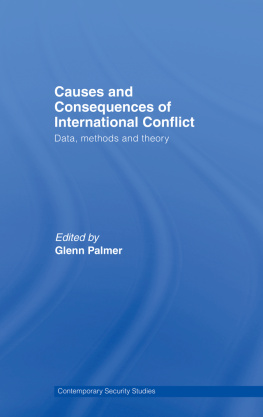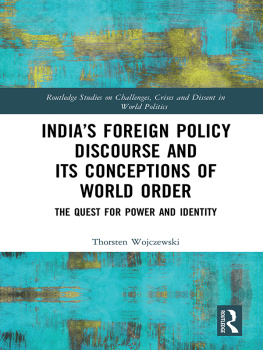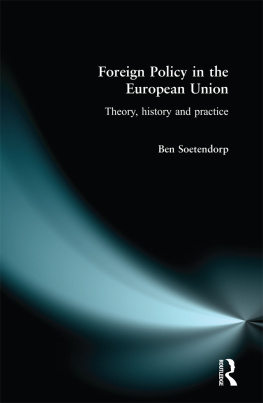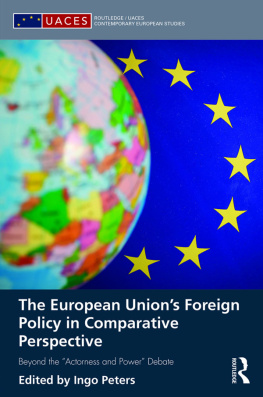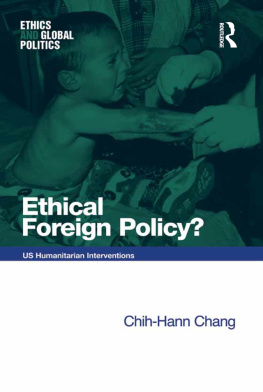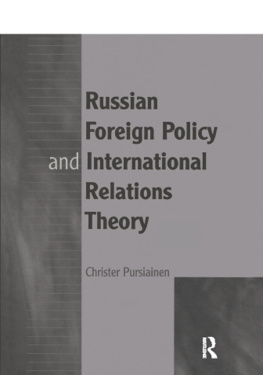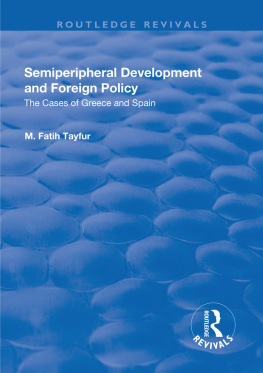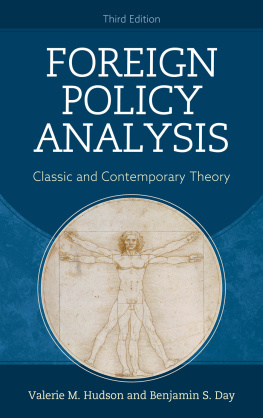Palmer Glenn - A Theory of Foreign Policy
Here you can read online Palmer Glenn - A Theory of Foreign Policy full text of the book (entire story) in english for free. Download pdf and epub, get meaning, cover and reviews about this ebook. publisher: Princeton University Press, genre: Politics. Description of the work, (preface) as well as reviews are available. Best literature library LitArk.com created for fans of good reading and offers a wide selection of genres:
Romance novel
Science fiction
Adventure
Detective
Science
History
Home and family
Prose
Art
Politics
Computer
Non-fiction
Religion
Business
Children
Humor
Choose a favorite category and find really read worthwhile books. Enjoy immersion in the world of imagination, feel the emotions of the characters or learn something new for yourself, make an fascinating discovery.

- Book:A Theory of Foreign Policy
- Author:
- Publisher:Princeton University Press
- Genre:
- Rating:5 / 5
- Favourites:Add to favourites
- Your mark:
- 100
- 1
- 2
- 3
- 4
- 5
A Theory of Foreign Policy: summary, description and annotation
We offer to read an annotation, description, summary or preface (depends on what the author of the book "A Theory of Foreign Policy" wrote himself). If you haven't found the necessary information about the book — write in the comments, we will try to find it.
A Theory of Foreign Policy — read online for free the complete book (whole text) full work
Below is the text of the book, divided by pages. System saving the place of the last page read, allows you to conveniently read the book "A Theory of Foreign Policy" online for free, without having to search again every time where you left off. Put a bookmark, and you can go to the page where you finished reading at any time.
Font size:
Interval:
Bookmark:
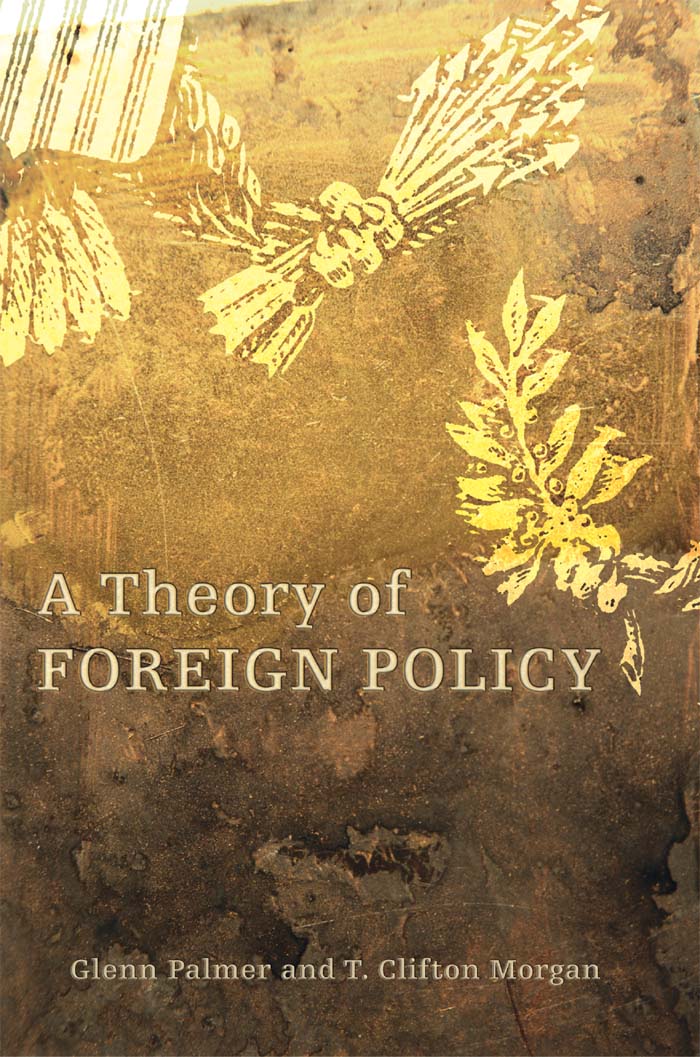
A THEORY OF FOREIGN POLICY
________________________________________________
A THEORY OF FOREIGN POLICY
________________________________________________
Glenn Palmer and T. Clifton Morgan
PRINCETON UNIVERSITY PRESS
PRINCETON AND OXFORD
Copyright 2006 by Princeton University Press
Published by Princeton University Press, 41 William Street, Princeton, New Jersey 08540
In the United Kingdom: Princeton University Press, 3 Market Place, Woodstock, Oxfordshire OX20 1SY
All Rights Reserved
Library of Congress Cataloging-in-Publication Data
Palmer, Glenn, 1954
A theory of foreign policy / by Glenn Palmer and T. Clifton Morgan.
p. cm.
Includes bibliographical references and index.
ISBN-13: 978-0-691-12359-2 (13-digit hardcover : alk. paper)
ISBN-10: 0-691-12359-4 (10-digit hardcover : alk. paper)
1. International relations. I. Morgan, T. Clifton, 1956 II. Title.
JZ1305.P35 2006
327.1s01dc22 2005016522
British Library Cataloging-in-Publication Data is available
This book has been composed in Minion
Printed on acid-free paper.
pup.princeton.edu
Printed in the United States ofAmerica
10 9 8 7 6 5 4 3 2 1
To our children
Einav and Ethan,
and
Tom and Emily
Tests of the Two-Good Theory
Conflict, Foreign Aid, and Military Spending
List of Tables
A S OFTEN HAPPENS in research, this project began as an investigation into one phenomenon and ended as an investigation into something somewhat different. We were always focused on the implications of considering foreign policy to be directed at achieving two goals, but we set out to explore how this would influence our understanding of the role of domestic politics in the making of foreign policy. We soon came to realize that understanding how domestic politics influences policy requires that we first have a base, ideal-type model of what foreign policy would be without the pushing and pulling of domestic actors. This book presents our efforts to develop such a model.
We are primarily motivated by a belief that traditional ways of evaluating foreign policy are fundamentally flawed. The most significant shortcoming is that analysts typically treat foreign policy as though it is aimed at achieving only one goalmaintaining the security of the state. Many have noted that security is an ambiguous concept and that almost anything can be said to enhance it. Our complaint is not that security is too abstract; rather, it is that we cannot understand foreign policy decisions if we assume they are aimed at producing only a single good. Accepting that foreign policy decisions often involve trade-offs is essential to understanding those decisions; this requires that we recognize that policy is aimed at achieving multiple goals.
There are an almost infinite number of interests states can pursue through their policies. It would not aid our understanding to enumerate them all, even if that were possible. To understand things, abstraction is necessary. Since we believe assuming that states have but one goal is unproductive because it stops us from seeing the trade-offs that decision makers confront and assuming that states have many goals is unproductive because it inhibits our ability to generalize, we take the simplest possible remedying step by assuming that states pursue two goods through their foreign policies. We call these change, which constitutes efforts to alter the status quo, and maintenance, which constitutes efforts to prevent changes in the status quo. This is clearly an abstraction, but it allows us to consider trade-offs and it is the simplest model that can do so.
We believe that the theory built upon this assumption is far superior to the alternatives. It provides a solid basis from which to explain specific decisions and it can serve as a foundation upon which to build a general understanding of the patterns in a particular states policies over time. Most important, it leads to a large number of testable hypotheses. Many of these are surprising; many are unique to this particular theory and enjoy a great deal of empirical support. Our efforts in this book are aimed at convincing our readers of these points.
Our theory is mathematical, and the hypotheses are formally derived. We subject many of the hypotheses to statistical tests. We have tried to make this book accessible to a broad readership, however, so the first half is presented in a non-technical fashion. The formal version of the theory is presented in chapter 5, but we first present an intuitive version in chapter 2. Chapters 3 and 4 are devoted to showing that the theory can provide a useful conceptual basis from which to describe and understand actual foreign policy events. We provide an account of U.S. foreign policy since World War II, an explanation of New Zealands decisions that effectively ended the defense agreement among Australia, New Zealand and the United States (ANZUS), an explanation of the Bolshevik decisions leading up to the Treaty of Brest-Litovsk, and an account of changes in the pattern of Chinese foreign policy. In chapters 6 and 7, we present the results of a number of statistical tests of the theorys hypotheses. We hope that this provides a convincing case that our theory is exceptionally rich and useful.
In the end, we hope to have accomplished several things. First, we hope to have developed a useful, fruitful, and general theory of comparative foreign policy. We seriously considered titling this book A Theory of Comparative Foreign Policy, but we have a strong sense that our sales would be hurt because most international relations scholars consider that to be a dead field. It should not be. Much can be learned by looking for general patterns in the foreign policies of various types of states and for looking for the factors that determine why states behave differently. Our theory is intended to apply universally. It does not account for just one states behavior, nor does it apply only to a brief historical era, nor does it explain only one type of behavior. It allows us to see commonalities across all these dimensions, and it provides an explanation for variations in behavior. We believe our theory provides a framework from which we can understand the specific decisions and general patterns of behavior adopted by all states at all times.
We also hope to have provided a theory that can serve as the basis for a great deal of additional research. We present the results of a large number of statistical analyses in this volume, but these test only a few of the hypotheses generated by the theory in only a few empirical contexts. The theory is amazingly rich in terms of the hypotheses that follow from it, particularly with respect to the phenomenon of foreign policy substitutability. Testing other hypotheses can serve to increase our confidence that this is a useful way of looking at the worldor convince us that we are on the wrong track. Moreover, we do not consider the job of developing this theory complete. In particular, the present version does not allow us to consider the effects of strategic interaction (that is, given that decision makers can anticipate how their actions will influence the actions of others, they should account for those anticipations in their decisions), nor does it allow us to consider the effects of domestic politics on foreign policy choices. These considerations would certainly complicate matters, but we believe they can be accommodated by generalizing, not completely changing, the theory.
Font size:
Interval:
Bookmark:
Similar books «A Theory of Foreign Policy»
Look at similar books to A Theory of Foreign Policy. We have selected literature similar in name and meaning in the hope of providing readers with more options to find new, interesting, not yet read works.
Discussion, reviews of the book A Theory of Foreign Policy and just readers' own opinions. Leave your comments, write what you think about the work, its meaning or the main characters. Specify what exactly you liked and what you didn't like, and why you think so.

